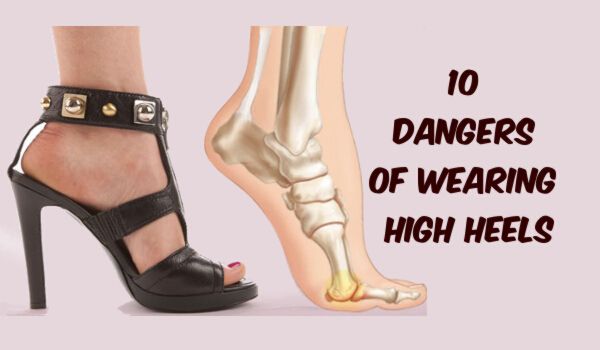10 Dangers of Wearing High Heels and Some Tips to Avoid Foot Pain: Which girl doesn’t like wearing a pair of stunning high heels? These days’ high heels have become major fashion statement for women across the world. These heeled shoes signify glamour and status now.
From tiny to sky high heels, these towering shoes are found in every women’s wardrobe.
But dear ladies, do you have any idea what these heels can do to your health and body posture? We agree that high heels make you look sophisticated but they also come with pain.
As per recent studies, high heels can cause permanent issues to the foot if you wear them regularly. These heels can harm your spine, knees, feet, ankle and hips.
Today, in this post we will discuss all the reasons why you should stop wearing such heels and also share a few tips to get rid of the discomfort caused by these killer shoes.
1. Foot Pain:
While you are standing barefoot, your heels and toes lie flat on the floor and your body weight is equally distributed but when you wear high heels, your feet arch gets flexed and all your weight shifts to the balls of your feet.
Not only have your feet taken the pain of all the weight but your toe bones also suffer. This weakens your ligaments and overtime with regular use of heels you start feeling pain.
This problem can get very serious and cause you permanent foot pain. You may also get sharp pain in your soles and toes.
2. Toe Nail Damage:
High heels are one of the most common causes of ingrown toe nails. This happens when the toes are forcefully compresses for a long period, which makes the big toe nails to grow into the skin. Additionally, this can lead to toe nail infection.
Also, high heels can cause your foot to slide down and crush your delicate toes which this can be very painful.
Another serious side effect of wearing such heels regularly is that they give you permanent hypertension in the toes.
3. Weakening of Ankles:
By wearing high heels, your ankles get forced to bend forward which can lead to instability. This kind of position of the feet can further become cause of impaired muscles and restricted blood circulation in the lower limbs.
You can also twist or sprain your ankles as they are not supposed to take so much pressure.
4. Joint Pain:
Other shoes can offer you shock absorption but with high heels you do not get any such benefit. When you wear high heeled shoes, you cannot rotate your feet naturally because you walk straight without bending.
This position causes the knees to take all the pressure and can lead to severe joint pain. Furthermore, there are chances that you can become arthritic if you wear heels for a very long time.
Whether you are standing or walking in heels, it can anyhow cause the cartilage in the joints starts wearing down.
5. Spine Flattening:
You have an S-shaped curve in your back which is built that way to absorb shock and reduce the stress on the vertebrae.
However, with heels on, you back gets straightened and this impacts the curve leading to spine flattening.
The increased weight on the balls of your feet causes the pelvis to bend forward and to cover that you tilt backward which increases your lower back arch.
This puts a lot of stress and strain on the lumbar spine. So, if you had been experiencing constant back pain, then high heels might be the reason.
6. Constricted Blood Vessels:
The tight shaped high heels compress the foot so much that leads to constricted blood flow to your lower limbs. Do not wear such tightly shaped shoes for longer durations as they can also cause the blood vessels to break.
7. Lack of Cushion:
High heels make your entire body weight lie on the balls of your feet which causes wearing off of natural padding that you have on the ball of the feet.
This can become extremely painful eventually because with the overuse of heels, the fat pad on bottom of your feet starts becoming thinner and thinner. With no natural cushion, you get general pain on the bottom of the feet.
8. Change in Walking Posture :
When you wear high heels for too long every day, your tendons and muscles become accustomed to standing and walking differently.
This affects the calf muscle, hamstrings, plantar fascia and Achilles; so when you go back to flat shoes, you get with an injury.
9. Weakens the Calves and Knees:
If you are wearing high heels from a very long time, then there are chances that you may develop short muscles and tendons which strain the calves.
Also, it can further lead to Osteoarthritis because knee joints can prematurely aged with too much usage of heels.
It is observed that women you are over-weight bear this burn more than anyone else, because the more you walk in high heels, the more you are bending your knees.
10. Callouses:
You might have observed this from the very first day, when you started wearing heels that your feet and toes get weird hard skin.
This actually happens become of the un-natural shape of shoes that you
force your feet into. The constant rubbing and pushing in such heeled shoes can lead to the hardening of the skin.
Now, you know why these killer heels should be absolutely avoided;
Let’s see what you can do to reduce foot pain caused by high heels.
- Use an ice pack in order to reduce any swelling and inflammation. It will be helpful to get rid of pain as well.
- Exercise your feet by doing some good stretching and flexing. You can stand on the edge of a step without your shoes. Put your weight on the balls of your feet and keep your heels extended off the edge. Now drop your heels down stretch.
- Regular massage will be helpful in reducing calf tightness caused by high heels.
- Replace your high heels with wedges. Also, you can add inserts or orthopaedic pads in your regular shoes which raise the heel to support the natural arch of your feet.
As long as you keep things in moderation, it is still fine. If you like wearing heels, make sure that you do not over use them.
Also, while picking up the heels, do not chose narrow shoes with pointed toe- design because that offers very less surface area.
You can pick heels which put lesser pressure on your feet such as kitten heels, wedges and platforms.



